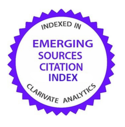Analysis of spatial dependence between stock indices
DOI:
https://doi.org/10.26360/2018_4Keywords:
distance, similarity, spatial dependence, stock returns, financial marketsAbstract
We discuss the benefits of using neighbourhood relations between stock markets based on time criteria, such as the time differences between countries and the simultaneous opening hours between markets, when they are compared with the distance in kilometres of their capitals. The objective is to find clusters between neighbouring stock indices. We used the Moran I statistic in order to analyse the spatial dependencies between indices. The results showed that the criterion based on simultaneous opening hours provide more relationships between neighbourhood markets. In addition, particularly between European markets, neighbourly relations are more intense during the 2008 financial crisis.
Downloads
References
Anselin, L. (1995). Local indicators of spatial association - LISA. Geographical Analysis 27, 93-115.
Arditti, F. D. (1967). Risk and the required return on equity. The Journal of Finance 22, 19-36.
Arnold, M., Stahlberg, S. y D. Wied (2013). Modeling different kinds of spatial dependence in stock returns. Empirical Economics 44, 761-774.
Asgharian, H. y C. Bengtsson (2006). Jump spillover in international equity markets. Journal of Financial Econometrics 4,167-203.
Asgharian, H., Hess, W. y L. Liu (2013). A spatial analysis of international stock market linkages. Journal of Banking & Finance 37, 4738-4754.
Asgharian, H. y M. Nossman (2011). Risk contagion among international stock markets. Journal of International Money and Finance 30, 22-38.
Boos, D. D. (1982). A test for asymmetry associated with the Hodges-Lehmann estimator. Journal of the American Statistical Association 77, 647-651.
Eckel, S., Löffler, G., Maurer, A. y V. Schmidt (2011). Measuring the effects of geographical distance on stock market correlation. Journal of Empirical Finance 18, 237-247.
Fernández, V. (2011). Spatial linkages in international financial markets. Quantitative Finance 11, 237-245.
Fernández-Avilés, G., Montero, J.-M. y A. Orlov (2012). Spatial modeling of stock market comovements. Finance Research Letters 9, 202-212.
Flavin, T., Hurley, M. J. y F. Rousseau (2002). Explaining stock market correlation: A gravity model approach. The Manchester School 70, 87-106.
Griffith, D. A. (2010). The Moran coefficient for non-normal data. Journal of Statistical Planning and Inference 140, 2980-2990.
Hamao, Y., Masulis, R. y V. Ng (1990). Correlations in price changes and volatility across international stock markets. Review of Financial Studies 3, 281-307.
Karolyi, G. y R. Stulz (1996). Why do markets move together? An investigation of U.S.-Japan stock return comovements. Journal of Finance 51, 951-86.
Longin, F. y B. Solnik (1995). Is the correlation in international equity returns constant: 1960-1990? Journal of International Money and Finance 14, 3-26.
Martin, V. y M. Dungey (2007). Unravelling financial market linkages during crises. Journal of Applied Econometrics 22, 89-119.
Moran, P. A. P. (1950). Notes on continuous stochastic phenomena. Biometrika 37, 17-23.
Weng, Y. y P. Gong (2016). Modeling spatial and temporal dependencies among global stock markets. Expert Systems with Applications 43, 175-185.
Downloads
Published
How to Cite
Issue
Section
License
Copyright (c) 2023 Carlos Acuña, Catalina Bolancé, Salvador Torra

This work is licensed under a Creative Commons Attribution-NonCommercial-NoDerivatives 4.0 International License.


















